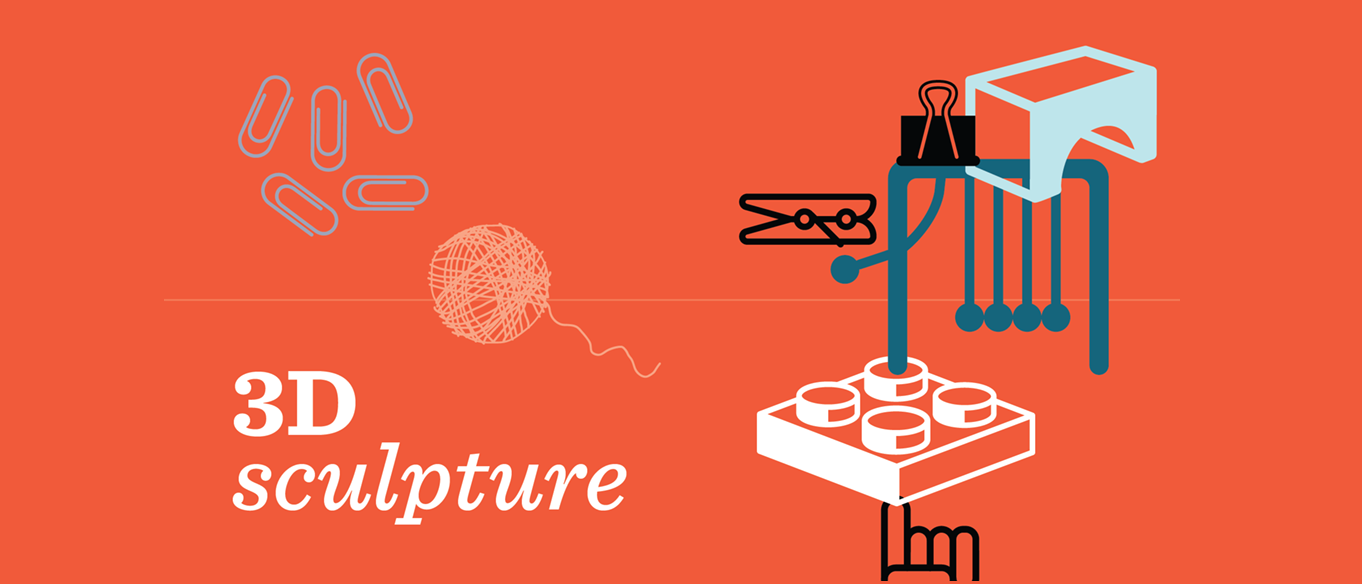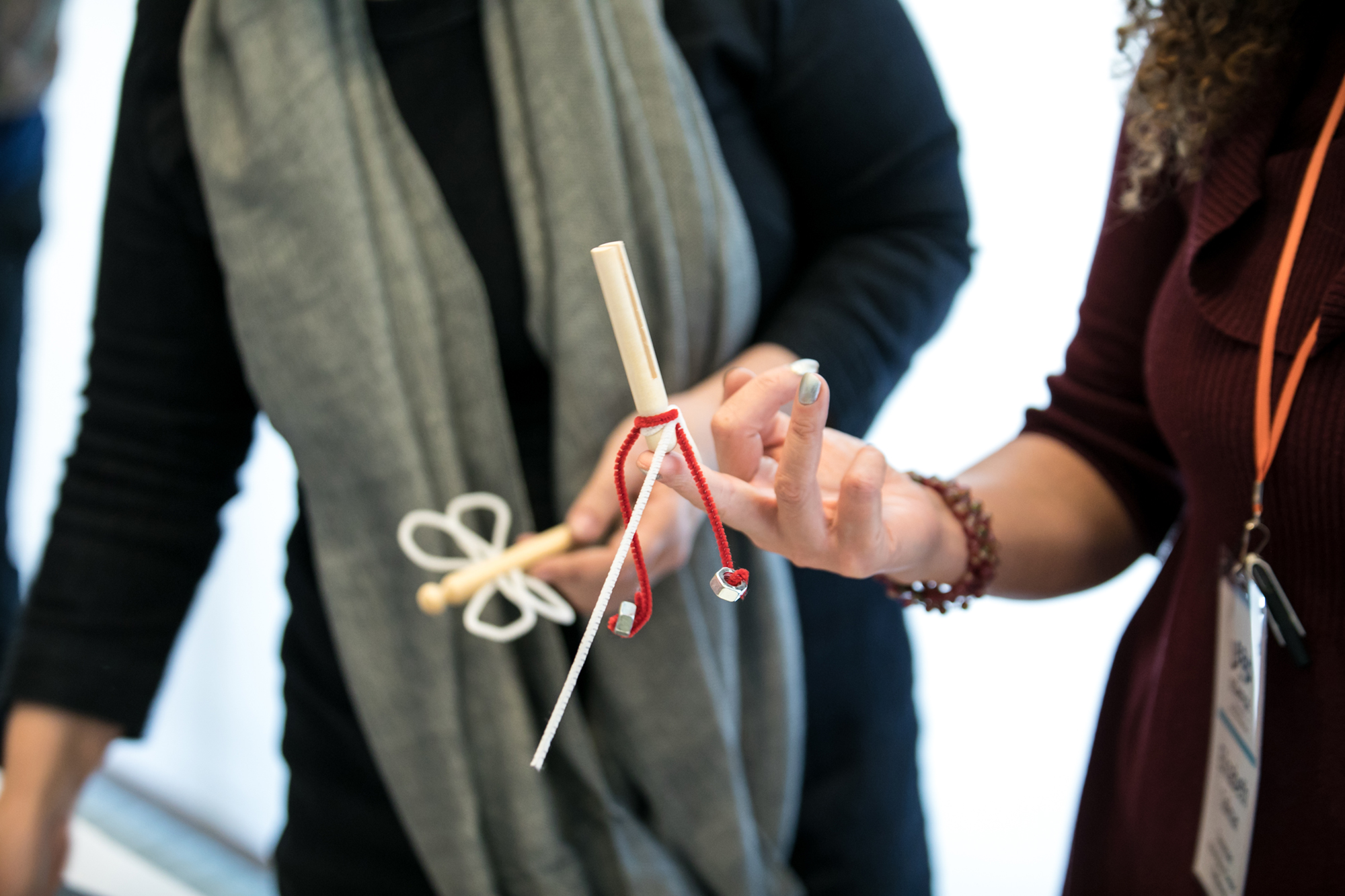
Have you ever thought about the science behind sculpture? Artists like Alexander Calder are known for their kinetic sculptures--three-dimensional works of art with parts that move and balance in interesting ways. To create a kinetic sculpture, you need to know something about the physical forces that make things balance—or not! Try this STEAM activity to explore balancing objects and create a moving sculpture that balances on your finger.
Age: 6+
Time: 20–40 minutes
Keywords: Balance, sculpture, STEAM
What you need:
- Ruler
- Penny or metal washer
- Tape
- Different objects to add to your sculpture, such as:
- Forks or spoons
- Pencils or crayons
- Clothespins
- Small toys or blocks
- Paper clips or buttons
- Shapes cut from paper or cardboard
- Metal washers, hex nuts, or bolts
- Materials to connect your sculpture objects together, such as:
- Pipe cleaners
- Rubber bands
- Yarn or string
- Twist-ties or thin wire
- Scissors (to cut the yarn or paper)
What to do:
1. Do some research about balance by trying to balance the ruler on the end of your finger. Hold one finger straight out in front of you with the fingernail facing the floor. Rest the flat part of the ruler on the end of your finger. Move the ruler around until you can make it balance on your finger. Where on the ruler did you need to put your finger to make it balance? Can you balance the ruler on its edge instead of the flat part? Can you balance it on the short edge at the end? Which is easiest or hardest?
Adaptation for diverse learners: if needed, use someone else’s finger to balance the ruler on.
2. Stick the penny or metal washer to one end of the ruler with a small piece of tape. Try to balance the ruler on your finger again. Where on the ruler did you need to put your finger to balance it this time?
3. Try moving the penny to different places on the ruler. How does that change where your finger needs to be? Can you balance the ruler and the penny together without using tape? What happens if you use more than one penny?
4. Test some of the other objects you collected, like the spoons, pencils, or toys, and see if you can balance them on one finger. How do they balance differently from the ruler? Which ones are easiest to balance?
5. Now you're ready to create a kinetic sculpture! Use the materials you collected to make a sculpture that can balance on one of your fingers and has parts that swing or move. If you like, you could start with an internet image search for “kinetic sculpture” or “balancing sculpture” to get some ideas.
6. Here are some questions to think about as you design your sculpture:
- What object will you use for the base (the part you balance on your finger)?
- Where could you attach other objects to the base: on top or underneath? On the end or in the middle? On one side or both sides?
- How could you make the sculpture balance in an unusual or surprising way?
- Which parts of your sculpture will move? How will you attach them?
- What else will make your sculpture fun and interesting to look at?
7. Test your sculpture frequently while you work by putting it on your finger to see how it balances. If an idea doesn’t work quite right the first time, keep trying! Scientists and artists often try many ideas before they find the one that works best.
8. When you’re happy with how your sculpture looks and moves, demonstrate it for a friend or family member. Show them how it balances, and talk about why you made it the way you did. What did you do or add to help it balance? What parts make it fun and interesting to look at? What did you try that didn’t work—and what did you change or do instead?
9. Other ideas to try:
- Build a stand for your sculpture that holds it the same way your finger does.
- Build another balancing sculpture using completely different materials.
- Build another sculpture using the same materials but arranged in a very different way.
What’s happening?
An object balances when its weight is evenly distributed around its base of support (whatever is holding it up). This depends on how much weight is on each side of the support, but also on how far away the weight is from the support. Your ruler weighs about the same all the way across, so it balanced when you put your finger (the base of support) right in the middle. Adding the penny made it heavier on one side, so you probably had to move your finger closer to the penny, leaving more of the ruler on the other side to balance the weight. Changing where you put the penny will change how far you have to move your finger to make it balance. Your kinetic sculpture works the same way: adding objects to one side, or moving them farther from the support, changes how the sculpture balances.


